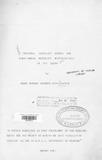| dc.description.abstract | The objective of the present study is two fold: The first
aim is to estimate, on the basis of data available and its nature,
the most plausible fertility levels for the Sudan as a whole, its
regions and rural-urban populations. The second purpose is to
summarize present informations on rural-urban fertility differentials
in the Sudan.
Chapter one, which is titled "Population, Economy and Society",
examines the factors widerlying the persistence of high fertility
and fertility differentials within and between the different regions
of the Sudan. This is done within a historical context covering three
periods: the pre-Colonial, the Colonial and the post-Colonial period
up to 1973, the census time . In brief, the cultural context, within
which the Sudanese society exists, is conducive to high fertility
while the Colonial period was characterized by variations in the
natural fertility prevailing then; the Colonial period had in fact
witnessed the start of fertility, mortality and migration, differences, other than the already existing variations in fertility,
as caused by the uneven distributions of economic plantations
agricultural schemes and the subsequent differences in health and
educational differences, in the various parts of the country. During
the post-Colonial period, high fertility and fertility differentials
have to exist due to: the absence of any significant structural
changes in the economic structure modelled since the Colonial time,
as an agricultural export economy; and the continuation of regional
inequalities in socio-economic development.
Chapter two deals with the analysis of demographic data reported
in the 1973 population census for the Sudan as a whole; its regions
and rural-urban populations. Data on age are erroneous, characterized
by age heaping and age misreporting. The systematic bias of the
interviewers to "age" the respondents, especially the female population,
has produced a systematic pattern of age misreporting characterized by
large-scale distortions, which is common to most of the underdeveloped countries in Asia and Africa. However, the identification of such pattern of age distortion is useful for the accuracy of the estimates
of fertility levels. Data on fertility, on the other hand, though
affected by women not stating their parity, agree with the assumptions
underlying the use of the Brass P/F ratio method, that it could give
good results.
Marital conditions is an important area in fertility analysis.
High fertility, according to the analysis of marital conditions undertaken
in Chapter three, is achieved through: early age at marriage,
low permanent celibacy and quicker rates of re-marriage of the divorced
and widowed women, especially in the rural areas. The latter tend to
imply higher rural than urban fertility.
Chapter four deals with regional fertility estimates. In the
light of the characteristics and the nature of data on age and fertility,
the best estimates of the fertility levels can only by obtained by
combining the different techniques available for estimating fertility
levels from a defective data. The estimates of fertility for the
Sudan as a whole, its regions and rural-urban populations, by combining
both the Brass P/F ratio method and the quasi-stable population method
are the most plausible that can be obtained. The estimates have located
Sudan among the African countries, whose fertility is high or perhaps
very high. They have also revealed fertility differences within
(rural-urban) and between the different regions of the Sudan.
Chapters five and six summarize present information on rural-urban
fertility differentials. For the Sudan as a whole, rural fertility is
slightly higher than urban fertility. This is also observed in all
regions except the Western region. In the latter region, urban fertility
is very slightly higher than rural fertility. Chief among the
factors that generate the observed difference in rural-urban fertility
levels are: (i) early age at marriage, affecting urban areas more than
- the rural areas; (ii) traditional practices, e.g. prolonged lactation
and/or abstinence, affecting rural areas more than urban areas, and
(iii) factors affecting the biological capacity of women to reproduce,
which are more apparent in the Western and Southern regions. However,
the effect of these factors in·rural and in the urban areas, tends to
offset each other, with the net effect that rural fertility, for the
Sudan as a whole, is slightly higher than urban fertility. On the other
hand, rural-urban migration has no effect on rural fertility. Infact,
rural fertility is highest in the Northern region, which is more
affected by the migration of its adult males.
A summary and conclusion is given in Chapter seven, supplemented
by a sect ion dealing with the implications of socio-economic development
for fertility levels and trends in the near future | en |

